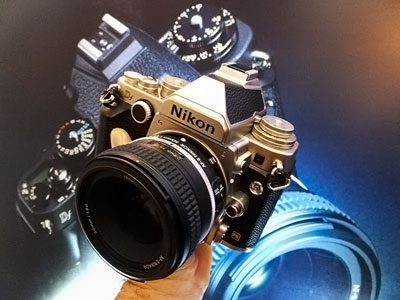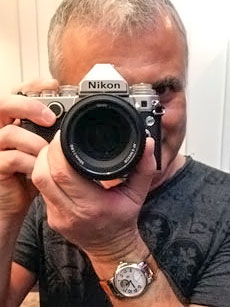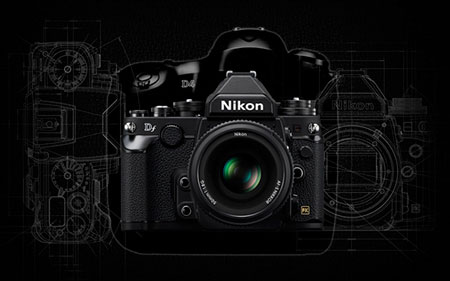First off: the Nikon Df is a kind of trinity between D4, Leica M and good old film. Right, of the D4 that costs $6k and Leica $7k. And I am the only one excited?! Online commentaries are rather condescending, accusing Nikon of too much and not enough retro for the sake of retro. But when you pick up the Nikon Df for the first time you’re surprised about its “leightweight.” This beauty of a beast, weighing no more than 765 grams, with this build quality, looks much heavier than it’s actually in your hands. Nice. Add the smooth tactile feel of the metal mechanical dials enabling a direct, intuitive operation that’s rewarded with clear, crisp “clicks,” and you’ll immediately realize that Nikon has hit a home run with this camera that’s already a collector’s item on the day of announcement. This camera is like a time travel. Totally reminiscent of my beloved Contax G2 — prominent front wheel, anyone? — the Nikon Df is a joy to hold and operate. Inspiring precision mechanics. And they’re just one part of the truly enjoyable photography experience the Df promises to deliver.

Whenever Nikon calls a camera an “F” it’s a serious piece of engineering. The Df is Nikon’s first digital F. Nikon Df, that’s a D series with “f” for “fusion,” as Nikon told me. Or f for putting “fun” back into photography I’m tempted to say. With its very own interpretation of an f-word Nikon means: “fusion of responsive, intuitive dial operations and flagship D4 image quality in the smallest and lightest FX format body.”
If the D4’s sensor in a truly inspiring package is not good enough, I wonder what is. For the ones who like to slow down and enjoy a beautiful photography tool of great craftsmanship, well their wait is over. The DF’s heart, its reliable sensor, is the D4’s, known for its solid low light rendering, spot-on colors and accurate tones — in short: stable, fast, responsive performance.
What could be wrong with all the functions one needs within reach of the right thumb and left hand. No need to dig deep into one of those menus burying much of what you never need; no function buttons to be programmed and no getting lost deep inside today’s myriad of options of operational overkill. Everything about the Df is for the photographer. There isn’t even a video mode.The operational layout of the Df may look a bit like that of a fine Swiss watch. Nothing wrong with that.
But when one has to read thoughts like A Response on the Nikon Df Distaste, then it becomes clear many photographers are scared of the thought of going back to the basics, because this camera represents what many of us have lost as photographers.
The price? Lack of features? This camera has what is has to have and is built to last. If the naysayers are right and the Df is good at what doesn’t matter and substandard at what truly matters, well then Nikon will follow up within reasonable time with a pimped up Dfx or Dfs or Dfwhatever. But whatever price you’re paying now — either $2,749 or $2,999 for the kit — what you spend for one Df now can be easily spent on two or three other cameras due to “natural” wear and tear and innovation cycles.
This Df is rock-solid. It may lack the latest bells and whistles and this and that help, convenience and functionality. That’s exactly what the “pure photography” is not about. The Df is not retro for the sake of it. It’s consciously saying no to clutter, ballast and distraction. And why didn’t Nikon choose a sensor with more resolution, say the D800’s? And why not mirrorless? We’ll come to that.

It’s neither an elegant Fujifilm X series nor a Leica M replica. The Nikon Df stands on its on as the first truly retro digital camera. Not the newest sensor? Not the highest resolution? We’ll come to that. But what about no more struggling with an overly complicated menu and dials and buttons that bury a myriad of functions? This camera allows photographers to focus on photography.
You’ll look in vain for one of those flashy movie or video mode buttons that have become standard in every other camera. What, no video?! The Nikon Df has no video. “If you want video you have to buy the Nikon D4,” says Nipat Pongsapitaksanti, product manager Nikon Thailand. “The Df is positioned for pure photography.”
In this camera, you want no video. It’s a camera that sure knows how to ignite passion for pure, undistracted photography. “Inspiration on Contact,” as Nikon says. Holding the camera feels like an immediate bonding between user and tool. Call me a hopeless romantic, I’m not making this up. Or as Tatsuya Yamaguchi puts it, president and managing director of Nikon Thailand:
Nikon has always been innovative, trustworthy and passionately committed. We’ve come a long way since the first Nikon SLR in 1959, the Nikkor F. The Nikon Df is the fusion of emotional benefits that come from owning and operating this camera with superior build quality. The Nikon Df increases the desire to express yourself through photography.
Know what? This is not just marketing babble. This is right to the point what the Df is all about. It’s a camera that doesn’t really target the Nikon user. It’s a retro camera for collectors, enthusiasts, admirers of beautiful mechanical tools, without excluding pros and the old and new generation of photographers. Anyone seeing you with this camera will think, “Cool, shooting film!”
In reality though the Df is much of a D4. It carries the same 16.2MP sensor and EXPEED 3 image processor as Nikon’s pro flagship model, although in a much more appealing and portable body that’s “made for the street and real world shooting”, says Mr. Nipat.

Meaning: an ISO range from 50 (Lo-1) to an astonishing 204,800 (hi-4), in a sealed body offering quiet mode — which actually will be a shame to use because the sound of that shutter is so sexy.
And why Nikon doesn’t go mirrorless with the Df?
Mr. Nipat: “Electronic viewfinders are not there yet. The optical viewfinder is real time, very bright with 100% frame coverage. Also, after a long shoot for several hours, photographers using EVF might get a headache.” And yes, no EVF eating the battery away. According to Nikon the battery delivers 1,400 shots per charge…
Some of the other goodies: 39 focus points, wireless mobile adapter and the body’s front wheel replacing the lens aperture ring.
The redesigned aspherical 50mm F1.8G Special Edition has a leather-like texture on the outside surface and a silver aluminum ring — a focus ring that reproduces the knurls of manual focus lenses. This Special Edition lens has the exactly same optics as the normal 50mm F1.8G, less the aperture ring.
It’s a compact, lightweight prime on a pretty much irresistible body — you’re all set for agile, nimble, intuitive photography, and that’s exactly what the Df is designed for.
Regarding a Nikon Df lens roadmap the company’s not very specific. But I guess it’s safe to expect further Df lens editions in the future, such as a wider and a tele prime.

Nikon claims the DF’s imager is also able to reproduce textures with a superior three-dimensional appearance at low sensitivities, such as ISO 100, without sacrificing dynamic range. In a simple, direct, straight to the point camera.
I’m told to be in a pole position for a production Df for reviewing. Stay tuned! As far as I can tell from handling the Nikon Df, chances are I’ll have to to review my very own Df pretty soon. Wasn’t allowed to insert a memory card yet to truly examine the camera, but isn’t the very enjoyment of holding the right gear in your hands already half of photography’s magic.
Such beautiful cameras don’t happen often. Nikon clearly put a lot of market research into the development of this camera. The Df isn’t for everybody, but it is what many have long been waiting for because this camera reminds us on what many of us have lost as photographers. Photography, to me, is as much about images as about enjoying good gear and the very experience/process of photography. The Df’s certainly an adequate tool for this. This camera is right down my alley; a camera, finally, that is like a trinity between D4, Leica M and film. You’ll get what you pay for.
(For detailed Nikon Df specs and more reviews and hands-on reports please read our continuously updated The Nikon Df File bringing you the latest on this truly different and interesting camera. And you might also want to visit the official Nikon Df Pure Photography site.)
+++ If you like what you read here, why not support THEME. Purchasing via these links doesn’t cost you a cent more. Appreciate! You can order the Nikon Df and Special Edition 50mm F1.8G lens from
- Amazon (black body / silver body / black kit / silver kit / 50mm F1.8G SE)
- B&H (black body / silver body / black kit / silver kit / 50mm F1.8G SE)
- Adorama (black body / silver body / black kit / silver kit / 50mm F1.8G SE)
Release date is Thursday, November 28, 2013.


